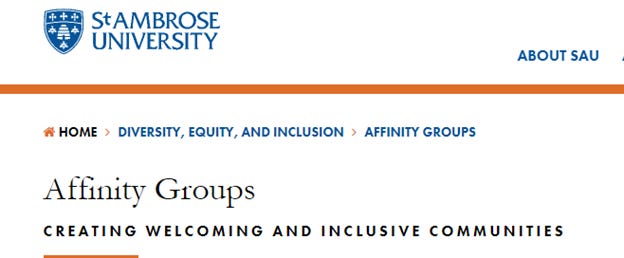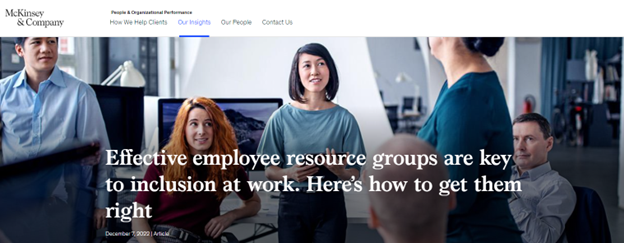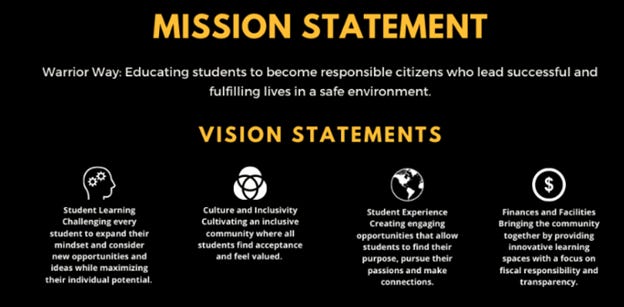As a preface I must explain the difference between orthodox and heterodox. Inclusion as we understand it means to require participation, involvement, encompassing, additions and the like. This is the orthodox definition of inclusion. Now, look at these two examples out of academia.
“Affinity groups build shared community amongst individuals with similar personal or professional interests based upon mutual understanding and/or identity.” - Syracuse University.
“In an effort to address our overall goal of making St. Ambrose a welcoming and inclusive community the University fully endorses the formation of Bee Inclusive Employee Affinity Work Groups.
The benefits to University employees by joining and participating with the Asian Bee Affinity group, will be that members will have a reliable place to go to if they seek advice, are missing relating to people with similar backgrounds, and want to find other that relate to the unique challenges due to being Asian in the U.S.
By joining the Hispanic and Latinx Bee Inclusive Affinity Group employees will get a space to discuss and celebrate their culture, language, and identity.
This affinity group is open to any employee on campus who self-identifies in the LGBTQ+ community or as an ally. In participating in this affinity group, members will receive a safe and confidential environment in which to voice concern and discuss LGBTQ+ issues on campus.” - St. Ambrose University
Affinity groups are inclusive. (Schools and HR departments nationwide will tell you so.)
Affinity groups are established around interest and identity. (They are discriminant.)
Affinity groups are places to share assumed, like experiences based on those interests and identities. (The are assumption based)
In the field of HR.
Affinity groups are simply replaced with employee resource groups.
“As companies have refined their diversity, equity, and inclusion (DEI) strategies to better meet the needs of workers and other stakeholders, many have begun reexamining the roles of their employee resource groups (ERGs), which are internal communities of workers with shared identities and interests.” - McKinsey & Company
Sanity check.
Are groups that discriminate based identity with respect to assumed interests and backgrounds “inclusive” according to our orthodox definition? How can HR departments and academia claim groups that specifically omit people are inclusive?
Clearly, inclusive does not mean what it means to the laymen.
In the fields of HR and academics inclusive has a more heterodox meaning. For people that love to read long dry articles, please see my explainer from a while ago here.
Starting with the assumption of an indoctrinated college graduate, society is a result of power struggles between white/black, fat/thin, male/female, rich/poor, heterosexual/LGB, sex typical/queer and neurotypical/neurodivergent. Each struggle for societal or systemic power within their opposites and across categories. These concepts are known as dialectical nature of identity and intersectionality.
People of usurping identities and interests exerting their own will over other identities and interests make ALL societies… always.
Once cultural hegemony is established as academics claim have existed in the U.S. since before it’s founding, (see 1619 project) the only way to ensure others are seen or heard is by actively silencing and censoring ideas and identities that are associated with the power in society. (called privilege)
For example, to allow gay people to express their own viewpoints, in an area or society at large, (again there is an assumed viewpoint associated with being gay) in a “safe” and “confidential” environment, all other viewpoints must be censored. Straight men must not be in the room but if they are, they may not speak. Allowing a straight man (an identity higher on the intersectionality scale than gay men) to say anything puts the gay man in “danger”, possibly physically but emotionally and at risk of being drowned out and spoken over.
This new heterodox definition of inclusion looks more like, creating an atmosphere where cultural identities, and the people we assign to them, with more societal power must be suppressed, silenced or omitted in order to guarantee a hyperinflated and unrealistic definition of safety for identities and narratives we claim are suppressed when censorship is not used.
Inclusion becomes an unrealistic excuse to censor ideas and people. Now, you can see that, affinity groups can absolutely be inclusive because we are specifically not allowing other ideas and perspectives that may challenge those allowed in the group.
So here is the practical application.
Southwest Licking School District Mission and Vision Statements
“Cultivating an inclusive community where all students find acceptance and feel valued.” - SWL School District Value Statement on Culture and Inclusion.
Start with the fact that the heterodox definition of inclusion is from the fields of academia and social sciences. Check
The heterodox definition requires a cultural component. It requires assumptions made about culture and how culture is established, specifically through power struggles that the orthodox definition does not require. Check
The heterodox definition of this word fits in with the concept of cultivating a community. The orthodox definition of inclusion makes no claims about the current state of a community, only that everyone should be able to participate.
I will have more to show you but the “woke” has made it to Southwest Licking School District. Buried in our district’s vision statement is a promise to suppress ideas and students that stand in the way of cultural change and this, this should worry you.







